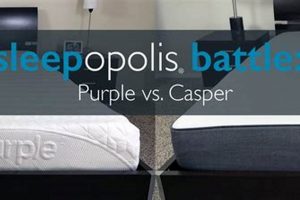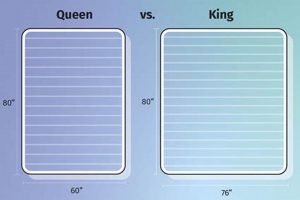The central comparison focuses on two primary options for achieving a comfortable sleeping surface while camping: inflatable pads designed specifically for outdoor use and air-filled mattresses, often associated with indoor or guest accommodations. The former prioritizes portability and insulation, while the latter generally emphasizes a larger sleeping area and potentially greater perceived comfort. For instance, a self-inflating model offers a balance of cushioning and compact storage, while a queen-sized inflatable unit provides ample space but requires a pump and more significant storage capacity.
Selecting the optimal sleep solution contributes significantly to the overall camping experience. Adequate rest is crucial for physical recovery after outdoor activities and for maintaining alertness and enjoyment. Historically, campers relied on rudimentary bedding, such as blankets or straw, which offered minimal insulation and comfort. The evolution of modern sleeping technologies, including advanced foams and durable, lightweight materials, has significantly improved the quality of sleep available in outdoor settings.
The following sections will delve into the specific characteristics of each option, examining factors such as portability, insulation, comfort, durability, and cost. Understanding these distinctions is essential for making an informed decision that aligns with individual needs, camping style, and environmental conditions, ultimately enhancing the comfort and success of any outdoor adventure.
Practical Considerations
Careful deliberation is required when selecting a sleep solution for camping. Several factors warrant consideration to ensure an optimal outcome.
Tip 1: Prioritize Portability for Backpacking. When backpacking, a lightweight and compact sleeping pad is essential. Ounce counting becomes crucial, and the ability to compress the unit for easy storage in a backpack is paramount.
Tip 2: Evaluate Insulation (R-Value). The R-value indicates thermal resistance. Colder conditions necessitate a higher R-value to prevent heat loss to the ground. Consider the expected temperatures during the camping trip.
Tip 3: Assess Comfort Preferences. Individual preferences for firmness and support vary. Air mattresses offer adjustable firmness, while some sleeping pads feature contoured designs for enhanced comfort.
Tip 4: Consider Durability and Material. The chosen sleep surface should withstand the rigors of the outdoors. Abrasion-resistant materials and reinforced construction are crucial, particularly in rugged environments.
Tip 5: Account for Inflation Method. Air mattresses typically require a pump, which adds weight and complexity. Self-inflating pads offer convenience but may be bulkier. Consider the availability of power and the effort required for inflation.
Tip 6: Understand Size and Dimensions. Match the sleeping surface dimensions to the tent floor size and the user’s height. Ensure adequate space for comfortable movement during sleep.
Tip 7: Budget Accordingly. Prices vary significantly based on features and brand. Establish a budget and compare options within that range, prioritizing essential features over superfluous ones.
Selecting the appropriate sleep solution contributes directly to the quality of rest obtained during a camping trip. Careful evaluation of the outlined factors allows for a more informed decision, optimizing comfort and minimizing potential drawbacks.
The subsequent section will synthesize the comparative analysis and provide a conclusive recommendation based on various camping scenarios.
1. Portability
Portability constitutes a fundamental differentiator in the evaluation of camping sleep systems. Its significance stems from the direct impact on the ease of transport and setup, particularly crucial for backpackers and those prioritizing minimalist gear strategies.
- Pack Weight
Weight is a primary metric in assessing portability. Sleeping pads, especially closed-cell foam or lightweight inflatable models, generally weigh significantly less than air mattresses. This reduced weight burden is critical for minimizing strain during extended hikes and maximizing overall carrying capacity. The difference can range from several pounds to upwards of ten, a substantial consideration for long-distance treks.
- Packed Volume
The volume occupied by a packed sleep system dictates the available space within a backpack or vehicle. Sleeping pads compress to a fraction of the size of a deflated air mattress. Compact storage is essential for efficient gear organization and optimizing the usable space for other essential items such as food, water, and safety equipment.
- Ease of Transport
Beyond weight and size, the ease of physically moving the sleep system influences its portability. Sleeping pads are typically rolled or folded into compact shapes, facilitating attachment to the exterior of a backpack or stowing within smaller compartments. Air mattresses, due to their bulkier nature, require larger storage bags and can be more cumbersome to maneuver, especially in confined spaces or challenging terrain.
- Setup Time and Complexity
While not directly a dimension of physical portability, the ease and speed of inflation/deflation affect the overall convenience. Sleeping pads, especially self-inflating varieties, require minimal setup, whereas air mattresses necessitate a pump (manual or electric) and a more involved inflation process. This difference in setup complexity contributes to the overall portability assessment, particularly when setting up or breaking down camp in adverse conditions or time constraints.
In summary, the degree to which a sleep system prioritizes portability directly correlates with its suitability for various camping styles. While air mattresses may offer superior comfort for car camping scenarios, the inherent limitations in weight, size, and setup complexity render sleeping pads a more practical and adaptable solution for those prioritizing mobility and efficient gear management.
2. Insulation (R-Value)
Insulation, quantified by R-value, plays a critical role in determining the thermal performance of sleep systems, directly influencing the selection between a camping sleeping pad and an air mattress. The R-value represents a material’s resistance to heat flow; a higher R-value indicates greater insulation. When a camper lies on a sleep surface, body heat is conducted away into the ground. Insufficient insulation can lead to significant heat loss, resulting in discomfort and potential hypothermia, even in moderately cool temperatures. Therefore, the effectiveness of either a sleeping pad or an air mattress in preventing conductive heat loss is paramount for maintaining a comfortable and safe sleeping environment.
Sleeping pads generally offer superior insulation compared to standard air mattresses due to the materials used in their construction. Many sleeping pads incorporate closed-cell foam or synthetic fills, which trap air and reduce heat transfer. Advanced models may utilize reflective barriers to further minimize radiative heat loss. Air mattresses, being primarily composed of air-filled chambers, provide minimal inherent insulation. While the air itself offers some resistance to heat flow, it is significantly less effective than the materials found in insulated sleeping pads. For instance, a basic air mattress might have an R-value close to 1.0, whereas a dedicated winter camping sleeping pad can achieve an R-value of 5.0 or higher. This difference highlights the critical importance of considering insulation when selecting a sleep system for cold-weather camping.
The practical implication of R-value differences becomes evident in real-world camping scenarios. A camper using a low-R-value air mattress in near-freezing temperatures will likely experience significant heat loss, leading to a restless and uncomfortable night. Conversely, a camper using a high-R-value sleeping pad in the same conditions will retain more body heat, resulting in a warmer and more restful sleep. Therefore, understanding the R-value and selecting a sleep system appropriate for the expected temperature range is crucial for ensuring a safe and comfortable camping experience. Challenges arise when campers prioritize comfort over insulation, leading to potential health risks in cold environments.
3. Pack Size
Pack size is a critical determinant when choosing between a camping sleeping pad and an air mattress. It directly influences the overall carrying capacity and organization within a backpack or vehicle, especially for activities demanding mobility and efficient space utilization.
- Compressed Volume and Backpack Capacity
The compressed volume of a sleep system dictates the amount of space it occupies within a pack. Sleeping pads, particularly those employing closed-cell foam or advanced inflatable designs, generally compress to a smaller volume compared to air mattresses. This difference is significant for backpackers adhering to strict weight and volume limits. Air mattresses, even when deflated, retain considerable bulk, potentially restricting space for other essential gear such as cooking equipment, clothing, and safety items. As an example, a rolled closed-cell foam pad might attach externally to a pack, freeing internal space, while a deflated air mattress might consume a substantial portion of the main compartment.
- Storage Efficiency in Vehicles
For car camping, pack size remains a relevant factor, albeit less critical than for backpacking. Efficient storage within a vehicle contributes to overall organization and accessibility at the campsite. While an air mattress may offer superior comfort, its larger packed size can limit the space available for other camping necessities, such as tents, coolers, and cooking supplies. A more compact sleeping pad allows for better space management and easier access to frequently used items. The ability to stack or arrange gear efficiently contributes to a more organized and functional campsite.
- Influence on Pack Weight Distribution
The size and shape of a packed sleep system also affect weight distribution within a backpack. An unevenly distributed load can lead to discomfort and fatigue during extended hikes. Sleeping pads, due to their more compact and uniform shape, generally facilitate more balanced weight distribution compared to the bulkier and less predictable shape of a deflated air mattress. Proper weight distribution enhances stability and reduces strain on the back and shoulders. Backpackers often prioritize gear with a compact profile to maintain a balanced load and minimize the risk of injury.
- Impact on Carry Options and External Attachment
The reduced packed volume of a sleeping pad expands carry options. Many pads can be securely attached to the outside of a backpack, freeing up valuable internal space and allowing for quick access. Air mattresses, due to their larger size and potential vulnerability to punctures, are less suited for external attachment. This limitation can constrain carry options and necessitate a larger backpack to accommodate the mattress internally. The versatility of a compact sleeping pad allows for greater flexibility in gear arrangement and overall pack configuration.
In summary, pack size serves as a key differentiator between sleeping pads and air mattresses, directly impacting portability, storage efficiency, and overall gear management. The choice between these sleep systems necessitates a careful evaluation of space constraints, carry options, and the relative importance of comfort versus practicality. Prioritizing a compact pack size enhances mobility and organization, contributing to a more enjoyable and efficient camping experience.
4. Durability
Durability represents a critical consideration when evaluating camping sleep systems, directly influencing the longevity and reliability of both sleeping pads and air mattresses. The inherent conditions of outdoor useabrasive surfaces, varying temperatures, and potential exposure to moistureplace significant demands on the materials and construction of these items. A failure in the field, such as a puncture or seam separation, can compromise sleep quality and overall safety, especially in remote locations. Therefore, understanding the factors that contribute to durability is essential for making an informed purchase decision that aligns with the intended use and environmental conditions.
Sleeping pads and air mattresses exhibit distinct durability characteristics based on their design and materials. Sleeping pads, particularly those constructed from closed-cell foam or reinforced inflatable designs, generally offer superior resistance to punctures and abrasions. The closed-cell structure of foam pads prevents complete deflation in the event of minor damage, maintaining a degree of insulation and support. Inflatable pads often incorporate durable fabrics with high thread counts and reinforced seams to minimize the risk of leaks. Air mattresses, while offering potential comfort advantages, are more susceptible to punctures from sharp objects and seam failures due to over-inflation or temperature fluctuations. The large, single-chamber design of many air mattresses means that a single puncture can result in complete deflation, rendering the mattress unusable. The choice of materialranging from thin PVC to more robust, coated fabricsalso significantly impacts the overall lifespan. For example, a lightweight air mattress used frequently on rocky terrain is far more likely to fail than a durable sleeping pad designed for similar conditions.
In summary, durability is a paramount factor in the selection of a camping sleep system. Sleeping pads typically offer greater resilience to punctures and abrasions, making them a more reliable choice for rugged environments. Air mattresses, while potentially more comfortable, require greater care and are more vulnerable to damage. The trade-off between comfort and durability must be carefully considered based on the intended use and the anticipated environmental conditions. Investing in a high-quality, durable sleep system ultimately translates to greater long-term value and peace of mind during outdoor adventures.
5. Inflation Ease
Inflation ease is a significant differentiator in the selection of a sleep system, impacting setup time and overall convenience. The effort required to inflate a camping sleep surface can range from simple self-inflation mechanisms to the necessity of manual or electric pumps, influencing user experience and suitability for varying camping scenarios.
- Self-Inflating Mechanisms
Certain sleeping pads employ self-inflation technology, utilizing open-cell foam that expands when a valve is opened, drawing air into the pad. While these pads may require some supplemental inflation by mouth to achieve desired firmness, the primary inflation process is automated. This minimizes the need for external pumps, simplifying setup, particularly in situations where power sources are unavailable or impractical. Self-inflation offers a balance between convenience and compact storage.
- Pump Requirements
Air mattresses invariably necessitate the use of a pump for inflation. Pumps may be manual (foot or hand-operated) or electric (battery-powered or requiring an external power source). Manual pumps require physical exertion and can be time-consuming, while electric pumps offer faster inflation but depend on a power supply or battery charge. The choice of pump impacts portability, as pumps add weight and bulk to the overall sleep system. Furthermore, the reliability of electric pumps in outdoor conditions must be considered, particularly in environments with temperature extremes or limited access to charging facilities.
- Inflation Time and Effort
The time and effort required for inflation are practical considerations. A self-inflating pad might be ready for use within minutes, whereas an air mattress inflated with a manual pump could take significantly longer, demanding considerable physical effort. Electric pumps expedite the process but may be noisy, potentially disturbing nearby campers. The ease of inflation is especially relevant after a long day of hiking or during inclement weather, where a quick and effortless setup is highly desirable.
- Valve Design and Compatibility
The design of the inflation valve influences the ease and efficiency of inflation and deflation. Valves should be robust, leak-proof, and compatible with various pump types. Some valves are designed for rapid deflation, facilitating quicker pack-up. Incompatibility between valve types and pump nozzles can lead to frustration and delays. Therefore, ensuring compatibility and assessing the valve’s overall quality are essential aspects of evaluating inflation ease.
The ease of inflation is a pivotal factor in differentiating camping sleep solutions. While self-inflating pads offer convenience and simplicity, air mattresses necessitate pumps and a more involved inflation process. The optimal choice depends on individual preferences, camping style, and the availability of power sources, ultimately affecting the overall convenience and enjoyment of the outdoor experience.
6. Comfort Level
Comfort level constitutes a primary determinant in the selection between a camping sleeping pad and an air mattress. The subjective perception of comfort is influenced by multiple factors, including the firmness of the sleeping surface, the degree of support provided, and the minimization of pressure points. A direct correlation exists between sleep quality and overall camping experience; inadequate comfort can lead to restless nights, fatigue, and diminished enjoyment of outdoor activities. Consequently, the assessment of comfort level is crucial for ensuring a restful and restorative sleep while camping. For example, individuals accustomed to the conforming support of memory foam mattresses may find the firmer surface of a traditional sleeping pad less comfortable initially, while others may prioritize the stability and ground feel offered by the pad over the bouncier sensation of an air mattress.
The comfort levels offered by sleeping pads and air mattresses differ significantly due to variations in design and materials. Air mattresses, by virtue of their air-filled construction, provide a more cushioned and often adjustable sleeping surface. The firmness can be regulated by adjusting the air pressure, allowing users to customize the level of support. However, this adjustability can also be a liability; over-inflation can create a rigid and uncomfortable surface, while under-inflation can lead to bottoming out and inadequate support. Sleeping pads, on the other hand, offer a more consistent and predictable level of support. Foam pads conform to the body’s contours, distributing weight evenly and reducing pressure points. Inflatable pads combine air chambers with internal baffling or foam layers to enhance comfort and stability. Consider, for instance, the experience of a side sleeper; an air mattress may allow for greater pressure relief on the hips and shoulders, while a well-designed sleeping pad with targeted cushioning can achieve a similar effect while minimizing motion transfer.
The practical significance of understanding the connection between comfort level and the choice of a sleep system lies in its impact on overall well-being and safety during camping trips. A well-rested camper is more alert, better able to cope with challenging conditions, and less prone to accidents. Moreover, adequate sleep is essential for physical recovery after strenuous activities, such as hiking or climbing. The challenge lies in balancing comfort considerations with other factors, such as portability, insulation, and durability. Selecting the optimal sleep system requires a careful assessment of individual needs, camping style, and environmental conditions, ensuring that comfort level is appropriately prioritized within the broader context of outdoor adventure.
7. Weight
Weight represents a critical factor when choosing between a camping sleeping pad and an air mattress. The mass of the sleep system directly correlates with the ease of transport, influencing the overall burden experienced during backpacking or hiking excursions. Greater weight necessitates increased physical exertion, potentially leading to fatigue and reduced mobility. Conversely, a lighter sleep system allows for more efficient movement and the ability to carry additional essential gear. Therefore, the connection between weight and the practicality of camping sleep options is substantial, dictating suitability for varying outdoor pursuits. As an illustration, consider a multi-day backpacking trip where every ounce contributes to the cumulative load. Opting for a heavy air mattress could significantly impede progress, while a lightweight sleeping pad would minimize the impact on the hiker’s stamina and agility.
The composition and construction of each sleep system contribute to the disparities in weight. Air mattresses, characterized by their air-filled chambers and often thicker materials, generally weigh more than sleeping pads designed for backpacking. Sleeping pads, utilizing lightweight foam or strategically designed inflatable structures, prioritize minimizing mass. Practical application of this knowledge involves considering the intended use. For car camping, where weight is less of a constraint, the increased comfort of an air mattress might outweigh the penalty in mass. However, for any activity requiring human-powered transport of gear, the weight of the sleep system becomes a paramount concern, potentially influencing the decision towards a lighter sleeping pad option. For example, a mountaineering expedition necessitates extreme weight consciousness, mandating the lightest possible gear configuration, thereby precluding the use of heavier air mattresses.
In summary, weight is an essential determinant when comparing camping sleep surfaces. The implications extend beyond mere convenience, affecting endurance, mobility, and the ability to carry necessary supplies. Careful evaluation of the weight characteristics of both air mattresses and sleeping pads, coupled with consideration of the specific camping context, is crucial for optimizing comfort and practicality in the outdoors. The challenge lies in balancing the desire for a comfortable sleep with the need to minimize physical strain and maximize efficiency.
Frequently Asked Questions
This section addresses common inquiries regarding the selection of appropriate sleep systems for camping, providing clarity on key considerations for informed decision-making.
Question 1: What constitutes the primary advantage of a camping sleeping pad over an air mattress in backpacking scenarios?
The primary advantage lies in reduced weight and pack size. Sleeping pads are generally significantly lighter and compress to a smaller volume, essential for minimizing burden during extended hikes.
Question 2: How does the R-value of a sleep system influence its suitability for cold-weather camping?
The R-value quantifies a material’s resistance to heat flow. Higher R-values indicate greater insulation, crucial for preventing heat loss to the ground in cold conditions. A low R-value can lead to discomfort and potential hypothermia.
Question 3: What are the implications of using an air mattress in rugged terrain?
Air mattresses are more susceptible to punctures and abrasions in rugged terrain. A single puncture can render the mattress unusable, compromising sleep quality and safety. Durable sleeping pads offer greater resistance to damage.
Question 4: What role does inflation ease play in the overall camping experience?
The ease of inflation impacts setup time and convenience. Self-inflating pads minimize the need for external pumps, simplifying setup. Air mattresses typically require manual or electric pumps, potentially adding complexity and time.
Question 5: How does the firmness of a sleep surface influence comfort and sleep quality?
Firmness preferences vary. Air mattresses offer adjustable firmness, while sleeping pads provide a more consistent level of support. Proper firmness is crucial for minimizing pressure points and ensuring restful sleep.
Question 6: What is the potential impact of an inadequate sleep system on overall camping safety?
Inadequate sleep can lead to fatigue, impaired judgment, and increased risk of accidents. A well-rested camper is more alert, better able to cope with challenging conditions, and less prone to errors.
Selecting the appropriate sleep system requires careful consideration of individual needs, camping style, and environmental conditions. Prioritizing essential features and understanding the trade-offs between comfort, portability, and durability contributes to a more successful and enjoyable outdoor experience.
The subsequent section will offer concluding remarks, summarizing key considerations and providing a final perspective on the selection of camping sleep systems.
Concluding Remarks
The preceding analysis elucidates critical distinctions between camping sleeping pad vs air mattress, emphasizing factors of portability, insulation, durability, and comfort. The selection of either option necessitates a thorough assessment of anticipated environmental conditions, intended camping style, and individual preferences. Camping sleeping pad offers inherent advantages in weight reduction and resilience, rendering it suitable for environments demanding mobility. Air mattress, conversely, prioritizes surface area and variable firmness, appealing to stationary settings with less emphasis on pack weight.
Ultimately, informed decision-making regarding sleeping surfaces for outdoor excursions necessitates a dispassionate evaluation of trade-offs. Prioritizing durability and insulation in challenging terrains ensures safety and well-being, while valuing compressibility and transportability is essential for itinerant expeditions. Continued technological advancements in material science will likely yield further refinements in both categories, offering optimized performance and versatility in the future. A mindful, educated selection process enhances both the physical and mental preparedness imperative for responsible engagement with the natural world.







